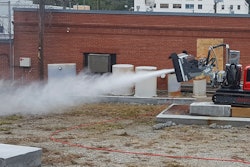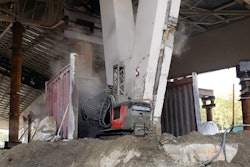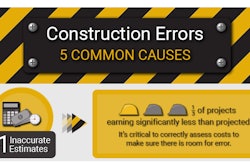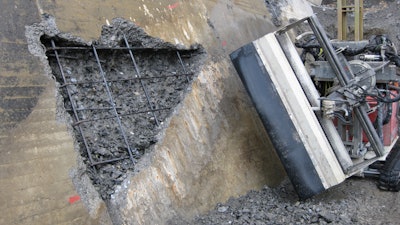
Placing concrete is a complex process. One slight miscalculation on any of the numerous variables can spoil a whole batch. And unfortunately, mistakes aren’t always evident right away. While concrete errors can certainly cause problems for timetables and budgets, advances in robotic concrete removal methods are making them easier to fix—without demolishing everything and starting over. For large, multi-phase construction projects, hydrodemolition offers a fast, cost-effective solution that can minimize the overall impact of concrete errors often getting contractors back on track for on-time project delivery.
Here are five common concrete errors hydrodemolition can help solve.
Formwork Failure
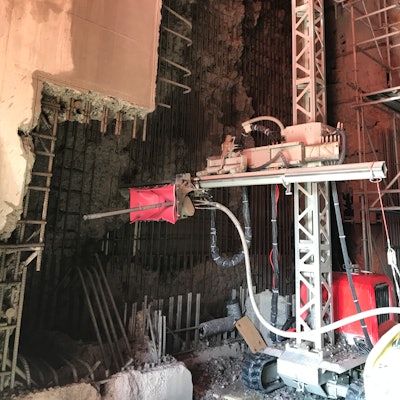 For large, multi-phase construction projects, hydrodemolition offers a fast, cost-effective solution that can minimize the overall impact of concrete errors — often getting contractors back on track for on-time project delivery.Aquajet
For large, multi-phase construction projects, hydrodemolition offers a fast, cost-effective solution that can minimize the overall impact of concrete errors — often getting contractors back on track for on-time project delivery.Aquajet
Hydrodemolition is an impact-free concrete removal method that is up to 25 times faster than jackhammers and other handheld equipment. Using high-pressure water jets as powerful as 40,000 psi, hydrodemolition blasts away layers of concrete, cleaning and descaling rebar in the process. This method also eliminates the risk of microfractures, creating a structurally sound foundation for any necessary concrete repairs. This high-tech, robotic solution also minimizes labor requirements, freeing up the rest of the crew to focus on other tasks—like getting concrete forms back in place—to keep the job on schedule.
For one contractor dealing with a formwork shift on a small overpass project, hydrodemolition provided an ideal solution. While part of the pour met specifications, the contractor needed to remove part of the deck and abutment to a depth of 3 ft. (.9 meters) and repour to correct the shift. Reaching the necessary depth with jackhammers wasn’t possible without destroying rebar and overall structural integrity. Using hydrodemolition, the contractor was able to complete removal with minimal impact on the structure.
More on Hydrodemolition From ForConstructionPros.com
Tomorrow’s Infrastructure Will Need More Efficiency – The Future of Hydrodemolition. Featuring Keith Armishaw from Aquajet, this Digging Deeper Podcast episode takes a look into hydrodemolition, it’s role in our country’s infrastructure rebuilding, and what we can look forward to in the technology.
5 Ways Accessories Expand Hydrodemolition Robot Capabilities. New add-ons allow contractors to maximize the value of existing equipment.
Benefits of Hydrodemolition for Noise-Restricted Construction Sites. Finding efficient, cost-effective ways to limit sound pollution is a major priority for contractors and hydrodemolition is gaining popularity for noise-restricted jobsites in concrete removal and surface preparation applications.
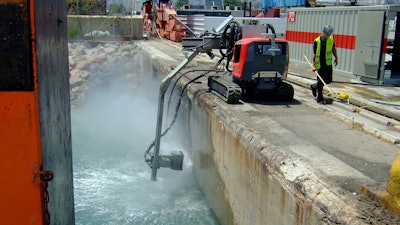 Hydrodemolition is an impact-free concrete removal method that is up to 25 times faster than jackhammers and other handheld equipment, increasing productivity.Aquajet
Hydrodemolition is an impact-free concrete removal method that is up to 25 times faster than jackhammers and other handheld equipment, increasing productivity.Aquajet
Concrete Segregation & Other Batch Problems
Another contractor relied on hydrodemolition’s selective removal capabilities to help solve a difficult concrete segregation problem. When water infiltrated the forms and washed out the cement paste, leaving just the aggregate behind, the contractor was able to set parameters for the hydrodemolition robot that removed just the segregated material. The sound concrete was left intact and ready for repair.
Let’s face it, a breaker doesn’t have a lot of finesse. In addition to damaging rebar and causing microfractures, this method can’t differentiate between segregated and sound concrete. In cases of obvious segregation, this might not be as much of a concern. But when removing poor-quality concrete in close proximity to good concrete, it might result in contractors removing too much or too little material.
Hydrodemolition robots allow contractors to adjust the robot’s stroke to control the depth of cuts and vary the pressure of the water jet depending on whether they are removing loose, deteriorated concrete or lowering the sound concrete to a pre-determined depth. This enables pinpoint accuracy in concrete segregation and bleeding situations. Once the parameters are set, the robot meticulously maneuvers over the designated area removing material according to set values. In some situations, this might include taking out everything to a specific depth. In others, it might involve demolishing only weak or deteriorated concrete by adjusting hydrodemolition robot’s settings, such as stroke or flow. Jackhammers and other methods cannot match this precision.
 Using hydrodemolition’s selective removal capabilities, contractors can remove only the poor-quality material, leaving the sound concrete intact and ready for repair.Aquajet
Using hydrodemolition’s selective removal capabilities, contractors can remove only the poor-quality material, leaving the sound concrete intact and ready for repair.Aquajet
Off-Spec Imbedded Materials
Sometimes the concrete error isn’t a result of the concrete mixture itself. In situations where off-spec materials such as rebar or anchors need to be removed from set concrete, hydrodemolition provides the power and precision necessary for fast, efficient removal.
In addition to setting parameters for stroke and pressure, cutting-edge hydrodemolition robots can be programmed to cut geometric shapes, such as circles, triangles, squares or parallelograms. This allows contractors to remove just enough material to reach the imbedded item, whether it’s just below the surface or several feet down.
For example, one contractor discovered they needed to replace bolts on anchors imbedded 3.3 ft. (1 meter) into the concrete. To reach that depth with a jackhammer would require a large hole—not to mention the resulting microfractures and damage to rebar and anchor. With a hydrodemolition robot, they were able to cut circular holes—just big enough to free the anchors—minimizing removal and increasing the efficiency of the repair project. The contractor was able to correct 12 to 15 anchors in 12 hours using a hydrodemolition robot.
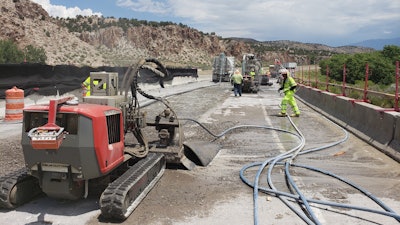 Independent pull-off tests have shown that the bonding strength of Hydrodemolition is much higher than what’s achieved with a jackhammer or mechanical method, resulting in repairs that can last up to three times longer.Aquajet
Independent pull-off tests have shown that the bonding strength of Hydrodemolition is much higher than what’s achieved with a jackhammer or mechanical method, resulting in repairs that can last up to three times longer.Aquajet
Concrete Repairs to Existing Structures
Hydrodemolition also provides an efficient solution for fixing concrete errors in existing structures—whether the repair is needed because something went wrong in the initial construction or as part of a renovation or rehabilitation, such as removing fire-damaged concrete.
One contractor tasked with removing an 8-ft. thick concrete pier on an active construction site for a hydropower plant was able to remove 4,944 cu.ft. (140 cubic meters) in just 53 days, averaging 141 cu.ft. (4 cubic meters) in a 12-hour shift. Once the demolition was complete, the repoured concrete benefited from the superior bonding surface created by the Hydrodemolition process.
The main reason for this is the absence of microfractures thanks to the impact-free process. Hydrodemolition also provides a cleaner surface, which eliminates the need for additional steps, such as sandblasting after using a jackhammer. The hydrodemolition process also leaves behind a rough, irregular surface. These combined features create the perfect profile for superior bonding strength, resulting in repairs that can last up to three times longer.
Additionally, hydrodemolition is recognized as one of few methods capable of achieving Concrete Surface Profiles 3 through 10, making it a versatile option for surface preparation applications. For example, a contractor could tackle a concrete water tank where old coatings need to be removed and the surface roughened to apply new paint or epoxy. This might require a CSP 3. On a subsequent project, where a bridge pillar needs reinforcement, the same contactor might be asked to provide a CSP 8 for the for the application of new concrete. This wouldn’t be a challenge with a Hydrodemolition robot.
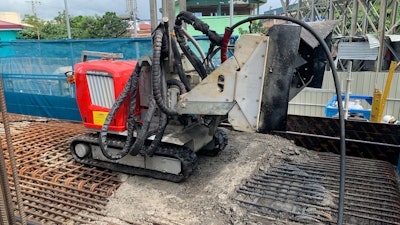 Hydrodemolition allows contractors to quickly go in and remove only the weak material without jeopardizing the overall structural integrity of remaining concrete or damaging rebar.Aquajet
Hydrodemolition allows contractors to quickly go in and remove only the weak material without jeopardizing the overall structural integrity of remaining concrete or damaging rebar.Aquajet
Compressive Strength Failure
By now it should be pretty clear that hydrodemolition is the ideal solution for concrete fixes that require productivity and precision. And nowhere is that more necessary than when facing compressive strength failure. Once a failure has been identified, hydrodemolition allows contractors to quickly go in and remove only the weak material without jeopardizing the overall structural integrity of remaining concrete or damaging rebar. When removal is complete, they’re left with a superior bonding surface that will provide a lasting correction.
Additionally, hydrodemolition robots are highly maneuverable, allowing contractors to tackle compressive strength failures wherever they occur—on horizontal, vertical, or even overhead surfaces. Some manufacturers also offer additional equipment that extends the robot’s reach or allows for specialized removal applications such as around columns, inside tunnels, or underwater. Lightweight, highly adaptable models are also available that make confined space applications safer and more productive.
Concrete errors can happen to anyone. Being ready with a fast, cost-effective solution allows forward-thinking contractors to maintain productivity in the face of unexpected delays.
About the Author
Keith Armishaw is the business development manager for Aquajet’s North American subsidiary. He has more than 25 years of industry and leadership experience.





